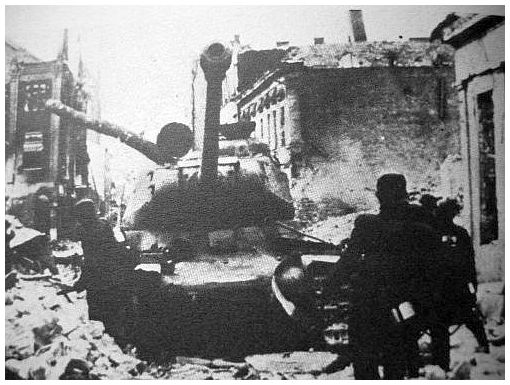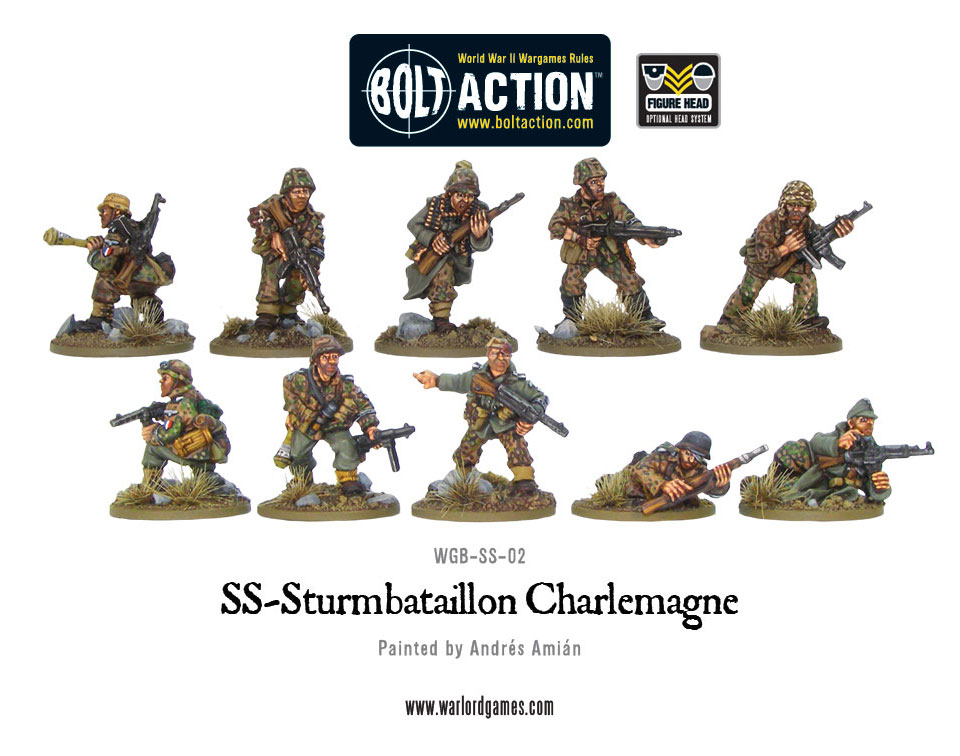The 33rd Waffen-SS Charlemagne (1st French) were French volunteers in the Wehrmacht and latterly the Waffen-SS during the Second World War. From estimates of 7,400 to 11,000 at its peak in 1944, the strength of the division fell to just sixty men in May 1945.
They were one of the last German units to see action in a pitched battle during the war, where they held central Berlin and the Führerbunker against the final onslaught of the vast Red Army. Knowing that they would not survive should Germany be defeated, they were among the last to surrender in the brutal urban combat, during the final days of the Battle for Berlin – the last days of Hitler’s much-vaunted Thousand Year Reich.

Charlemagne
In September 1944, a new unit, the Waffen-Grenadier-Brigade der SS “Charlemagne”, also known as the Französische Brigade der SS was formed out of the remnants of the Legion of French Volunteers Against Bolshevism (LVF) and French Sturmbrigade, both of which were disbanded. Joining them were French collaborators fleeing the Allied advance in the west, as well as Frenchmen from the German Navy, the National Socialist Motor Corps (NSKK), the Organisation Todt, a construction unit and the Vichy French Milice. Some sources claim that the unit also included volunteers from some French colonies and Switzerland. SS-Brigadeführer Gustav Krukenberg took actual command with SS-Oberführer Edgar Puaud as nominal French commander.
The two main infantry regiments were Waffen-Grenadier Regiment der SS 57 and 58. Veterans of the Sturmbrigade were the nucleus of Regiment 57 and the LVF formed the core of Regiment 58. The LVF also manned the artillery battalion, the headquarters company and the engineer company. The reaction of the LVF to their transfer into the Waffen-SS was mixed.
In early 1945, SS-Oberführer Puaud received assurance from Reichsführer-SS Heinrich Himmler that his men would not be sent to the Western Front, where they might have to fight fellow Frenchmen. He was also told that they would fight under the French flag and continue to have Catholic military chaplains. Himmler also promised that France would regain its sovereignty after Germany’s victory.
In February 1945, the unit was officially upgraded to a division and renamed 33. Waffen-Grenadier-Division der SS “Charlemagne”. However, this division was severely undermanned with only 7,340 men. The Charlemagne Division was sent to fight the Red Army in Poland, but on 25 February it was attacked while deploying from the railhead at Hammerstein (present day Czarne) in Pomerania, by troops of the Soviet 1st Belorussian Front. Opposing the Frenchmen were four Red Army infantry divisions and two tank brigades. The lightly armed French troops had not re-equipped prior to their departure, and they had no radios and few maps. The only bright spot for the Frenchmen was that they managed to destroy 19 T-34 tanks with panzerfausts!
On the night of 3 March, the Charlemagne survivors were sent to defend the nearby town of Körlin with orders to “hold at all costs”. At noon the next day, a strong Red Army force hit Körlin from the southwest. The French fought back desperately and were able to hold their positions throughout the day. The Division was ordered to immediately withdraw to the west, to avoid being trapped, and was broken into three battlegroups. Only the battlegroup commanded by Krukenberg survived, as they retreated to the Baltic coast, and were evacuated by sea to Denmark and later sent to Neustrelitz for refitting. Around 4,800 men had been lost, including SS-Oberführer Puaud.

Defence of Berlin
By early April 1945, Krukenberg now commanded only about 700 men organised into a single infantry regiment with two battalions (Battalions 57 and 58) and one heavy support battalion without equipment. He released about 400 men to serve in a construction battalion; the remainder, numbering about 350, but well armed with panzerfausts and assault rifles, deployed to Berlin to conduct a delaying action against the approaching Soviet Army.
On 23 April the Reich Chancellery in Berlin ordered Krukenberg to proceed to the capital with his men, who were reorganised as Sturmbataillon (“assault battalion”) “Charlemagne”. Between 320 and 330 French troops arrived in Berlin on 24 April after a long detour to avoid Soviet advance columns. (The French SS men had been attempting to cross the Falkenrehde canal bridge which was blown up under them by men of the Volkssturm who thought they were a Soviet column). Sturmbataillon “Charlemagne” was attached to the 11th SS Volunteer Panzergrenadier Division “Nordland”. The arrival of the Sturmbataillon bolstered the Nordland Division whose “Norge” and “Danmark” Panzergrenadier regiments had been decimated in the fighting. Both equaled roughly a battalion. SS-Brigadeführer Krukenberg was appointed the commander of (Berlin) Defence Sector C.
The soldiers noted that the first night in Berlin was unnaturally quiet. They heard people dancing and laughing, but no sounds of fighting were audible except for the occasional distant sound of Soviet artillery. They walked from West to East Berlin, to a brewery near the Hermannplatz. Here the fighting began, with Hitler Youth firing panzerfausts at Soviet tanks belonging to advance guards near the Tempelhof Aerodrome. Soon some members of the Sturmbataillon joined the Hitler Youth in tank hunting sorties.
Supported by Tiger II tanks and the 11th SS Panzer-Battalion “Hermann von Salza”, the Sturmbataillon took part in a counterattack on the morning of 26 April in Neukölln, a district in south eastern Berlin near the Sonnenallee. The counterattack ran into an ambush by Soviet troops using a captured German Panther tank, although this may have been a ‘friendly-fire’ incident. The regiment lost half of the available troops in Neukölln on the first day. It later defended Neukölln’s Town Hall. Given that Neukölln was heavily penetrated by Soviet combat groups, Krukenberg prepared fallback positions for Sector C defenders around Hermannplatz. He moved his headquarters into the opera house. As the Nordland Division withdrew towards Hermannplatz the French SS and one-hundred Hitler Youth attached to their group destroyed 14 Soviet tanks with panzerfausts; one machine gun position by the Halensee bridge managed to hold up any Soviet advance in that area for 48 hours.
The Charlemagne’s tank-busting tactics were straightforward: first the accompanying Russian infantry would be killed or pinned down with machine gun fire. Then the panzerfaust-armed men would work forward through the rubble to blow away the enemy armour. In between assaults the Soviet artillery pounded the area, causing terrible casualties but providing good cover for the survivors.
The Soviet advance into Berlin followed a pattern of massive shelling followed by assaults using battle groups of about 80 men in each, with tank escorts and close artillery support. On 27 April, after a spirited but futile defence, the remnants of Nordland were pushed back into the central government district (Zitadelle sector) in Defence sector Z. There, Krukenberg’s Nordland headquarters was a carriage in the Stadtmitte U-Bahn station. Fighting was very heavy and by 28 April, approximately 108 Soviet tanks had been destroyed in the southeast of Berlin within the S-Bahn. Sixty-two of those were destroyed by the efforts of the Charlemagne Sturmbataillon alone, which was now under the command of Henri Joseph Fenet. Fenet and his battalion were given the area of Neukölln, Belle Alliance Platz, Wilhelmstrasse and the Friedrichstrasse to defend.
Fenet, who was now wounded in the foot, remained with his battalion as they withdrew to the vicinity of the Reich Aviation Ministry in the central government district under the command of SS-Brigadeführer Wilhelm Mohnke. For the success of the battalion during the Battle in Berlin, Mohnke awarded Fenet the Knight’s Cross of the Iron Cross.
On 28 April, the Red Army started a full-scale offensive into the central sector. Fighting was intense, the Sturmbataillon Charlemagne was in the center of the battle zone around the Reich Chancellery. SS-Unterscharführer Eugene Vaulot, who had destroyed two tanks in Neukölln, used his Panzerfausts to claim six more near the Führerbunker. He was awarded the Knight’s Cross of the Iron Cross by Krukenberg during a candlelight ceremony on a subway platform on 29 April. Vaulot did not survive the battle.
The French Charlemagne SS were the last defenders of Hitler’s Führerbunker, remaining there until 2 May to prevent the Soviets from capturing it on May Day.
Aftermath
Reduced to approximately thirty able men, most members of the Sturmbataillon were been captured or escaped Berlin on their own, or in small groups. Most of those who made it to France were denounced and sent to Allied prisons and camps. For example, SS-Hauptsturmführer Henri Joseph Fenet was sentenced to 20 years of forced labour, but was released from prison in 1959. Others were shot upon capture by the French authorities. General Philip Leclerc, the French divisional commander who had served under the Americans, was presented with a defiant group of 11-12 captured Charlemagne Division men. The Free French General immediately asked them why they wore a German uniform, to which one of them replied by asking the General why he wore an American one (the Free French wore modified US army uniforms). The group of French Waffen-SS men was later executed without any form of military tribunal procedure.
Recorded Atrocities Nil
One point of note is that the Charlemagne division has no recorded atrocities against its name. Within the Waffen-SS, whose record is stained with massacres, executions and brutality, Charlemagne’s record is unblemished, despite fighting on the Russian front – a theatre known for its brutality and excess.







